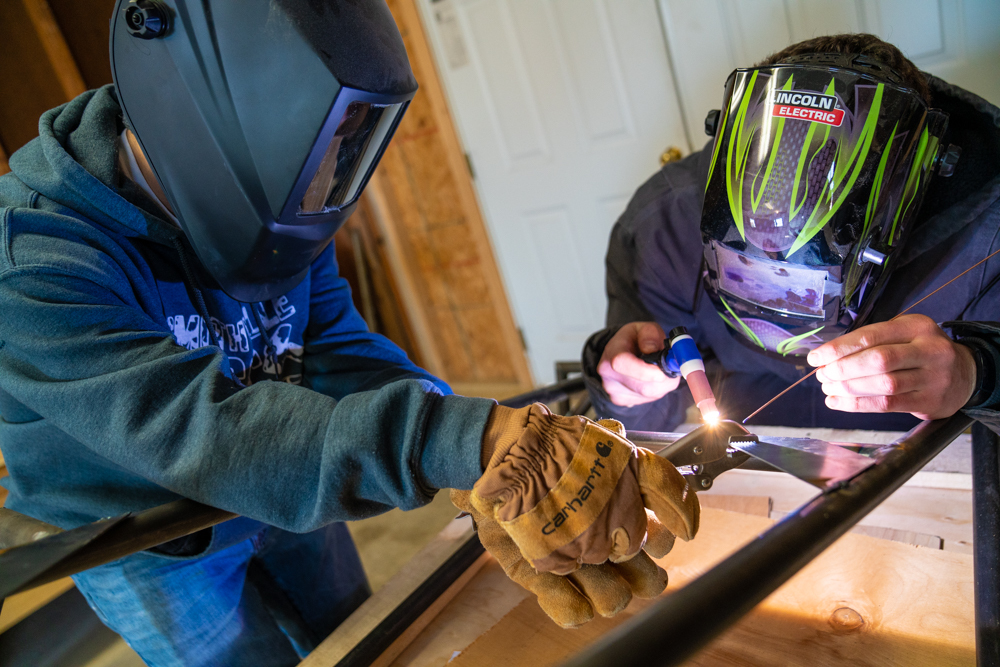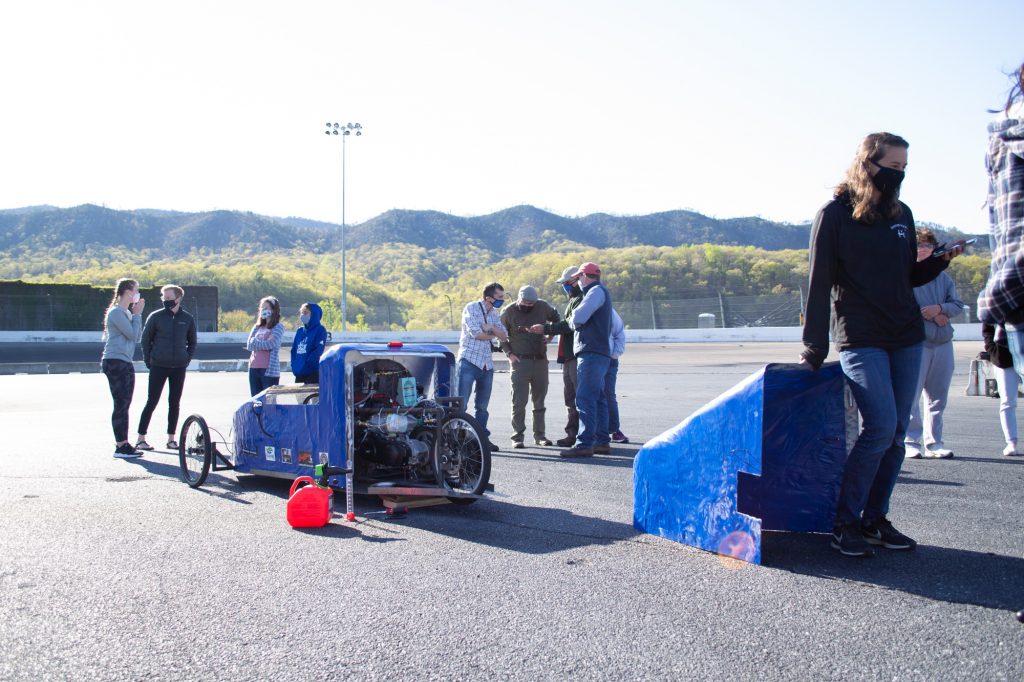On a bright and windy April day, against a gorgeous mountain backdrop, a little blue wedge zipped around the Shenandoah Speedway in Shenandoah, Va. It averaged a conservative speed in the mid-20 miles per hour, but the most striking feature of this car was its fuel consumption. In its best trial run, it got 204 miles to the gallon.
The car was built by a team of Eastern Mennonite University (EMU) students who’ve been on a long and winding road to get it to a track. Under the leadership of mechanical engineering major Ben Bontrager-Singer, the group began designing and building their supermileage car in the fall of 2019, with the expectation of competing in the 2020 Shell Eco-marathon held at the Sonoma Raceway in California.

Of course, that was cancelled due to the pandemic. The team then planned on fine-tuning their creation and competing in the eco-marathon this year, thinking that surely COVID-19 would have been a distant memory by now, and – cancelled again.
So the roadster’s maiden voyage was to the speedway, where Bontrager-Singer and his team had planned to hold a tête-à-tête with James Madison University’s eco-marathon team. However, the Dukes’ supermileage car was undergoing technical difficulties, and they weren’t able to attend. So, after more than a year of planning, building, calibrating, and re-planning, the Royals’ supermileage car was finally run through its paces, albeit sans contender.

“It was extremely satisfying to get to this point,” said Bontrager-Singer. “I always knew that we would eventually have a ‘finished’ product but it really never felt close until we were actually at the raceway – although it does feel a little funny to use the word finished. We are in the prototype category of the Shell Eco-Marathon competition and indeed this was our first prototype … this is really just the tip of the iceberg.”

The car did achieve a gas mileage of 204 per gallon on its final test run of the day, although to achieve that mind-boggling number, driver Caleb Hostetler used a coast-and-burn strategy of accelerating up to 25 miles per hour and then cutting the engine and coasting down to 5 miles per hour. On the two previous trials, when Hostetler and Tessa Waidelich maintained their speed in the mid-20s, they still got over 135 miles to the gallon.
Bontrager-Singer wasn’t surprised, though. He knew what they had.
“I was very excited and proud of our performance on Friday,” he said. “It certainly was satisfying to see it really be as effective as we had hoped. We hadn’t had enough time to really test the strategy before getting to the track so it was exciting to see it be so effective. It was also really nice to see so many people make the trip to Shenandoah to watch.”

In addition to driving, Hostetler is also on the engine and electric fuel injection team.
“This part of the car has been frustrating but also satisfying for me, as electricity, microcontrollers, and computers are the things I have some experience working with,” he said. “When we began this project two falls ago, I also signed up to be one of the potential drivers. That may or may not still happen depending on when the competition happens, but I am still having a great time working on this project.”
Even without the opportunity to test their ride against the hundreds of others that would normally compete at the Eco-Marathon each year, the team has already identified improvements they’d like to make before their first race, whenever that may be. Bontrager-Singer’s excitement for the car’s future has not wavered despite the many setbacks the pandemic has posed.
“Most of our team is only sophomores and freshmen at this point so we have time to do a lot more,” he said. “Just for next year, there have already been talks about going electric or completely building a custom drivetrain. Most likely we will have to build a new body to improve driver visibility. I think a reasonable goal for next year would be to double our fuel economy.

Waidelich said the teammates have become close friends through this project.
“In my opinion, one of the coolest things about this project is how well the group works with each other,” she said. “When we run into problems or an idea goes south, we reconvene and listen to each other’s ideas to come up with a new plan.”
Bontrager-Singer lauded his teammates for their commitment to the car. By his rough estimate, they’ve collectively put 2,300 hours into the vehicle so far.
“I am so proud of our team and all that we have accomplished. Being in Super-Mileage Car is a huge commitment and can be tiring and frustrating. Every team member demonstrated supreme commitment and perseverance to get to this point,” he said.


Congratulations, Ben and the Supermilage Team! Wow, you made it through all of the construction challenges and came up with a really reliable car! I can’t believe you worked out the tuning of the engine so well that you could shut it off and consistently restart it again at 5 mph.
You all are awesome! Congratulations on your success!!
Congrats Tessa and Ben!! Really awesome project!!